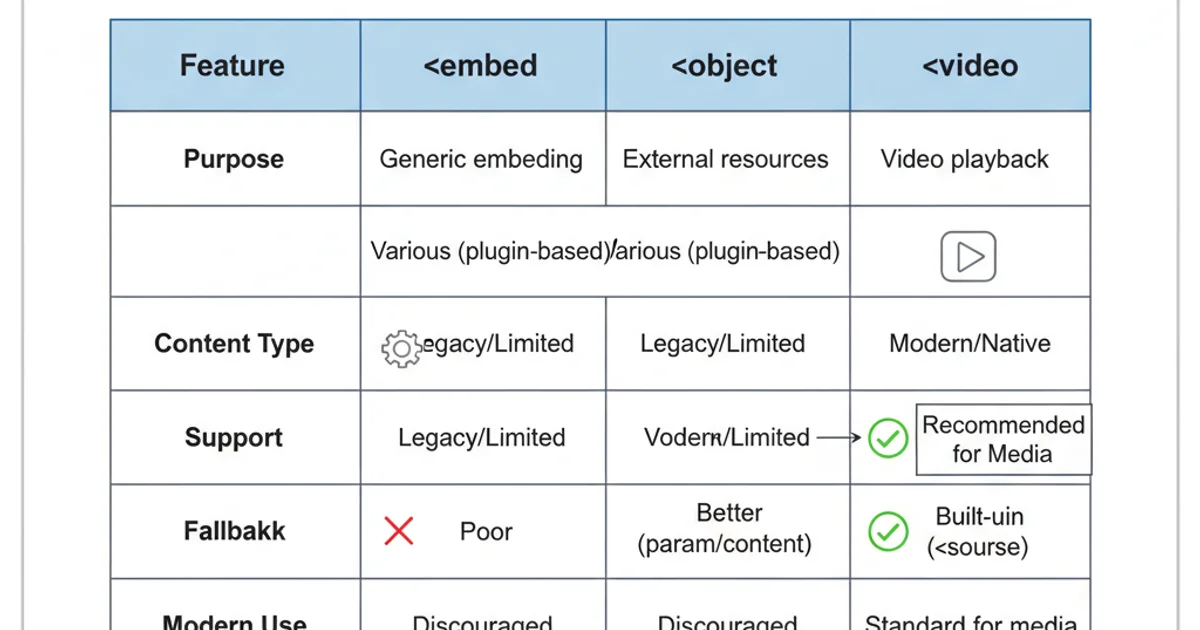Difference between embed, object, and video tags?
Categories:
Understanding HTML Media:

Explore the differences and best use cases for HTML's
Integrating multimedia content into web pages has evolved significantly since the early days of the internet. HTML provides several tags for this purpose, each with its own history, capabilities, and ideal use cases. This article delves into the distinctions between the <embed>, <object>, and <video> tags, helping you choose the right tool for your multimedia needs.
The
The <embed> tag is primarily used to embed external applications or interactive content, often non-HTML, into an HTML document. Historically, it was widely used for embedding Flash animations, Java applets, and other plugin-based content. While HTML5 officially standardized it, its use has declined significantly due to security concerns, performance issues, and the rise of native HTML5 media capabilities. It's generally recommended to avoid <embed> for modern web development, especially for video or audio, unless you have a specific legacy requirement.
<embed type="application/x-shockwave-flash" src="movie.swf" width="400" height="300">
<embed type="application/pdf" src="document.pdf" width="500" height="600">
Example usage of the <embed> tag for Flash and PDF content.
The
The <object> tag is a more generic and powerful embedding mechanism than <embed>. It can embed a wide range of content, including images, other HTML documents, PDFs, Flash animations, and even ActiveX controls. One of its key advantages is its ability to provide fallback content. If the browser cannot render the primary content specified by the <object> tag, it will display the content nested within the tag. This makes it more robust for handling various media types and browser capabilities. However, like <embed>, its use for video and audio has largely been superseded by the <video> and <audio> tags in HTML5.
<object data="movie.swf" type="application/x-shockwave-flash" width="400" height="300">
<param name="movie" value="movie.swf">
<p>Your browser does not support Flash. Please install the Flash plugin.</p>
</object>
<object data="document.pdf" type="application/pdf" width="500" height="600">
<p>It appears you don't have a PDF plugin for this browser. You can <a href="document.pdf">click here to download the PDF file.</a></p>
</object>
Examples of the <object> tag with fallback content for Flash and PDF.
The
Introduced with HTML5, the <video> tag is the native and preferred way to embed video content directly into web pages without requiring third-party plugins. It offers a standardized API for controlling playback, supports various video formats (MP4, WebM, Ogg), and integrates seamlessly with CSS for styling and JavaScript for advanced interactivity. The <video> tag also supports multiple <source> elements, allowing you to provide different video formats for broader browser compatibility, and includes built-in controls, autoplay, loop, and poster attributes. This tag represents the modern approach to video embedding, prioritizing performance, accessibility, and user experience.
<video width="640" height="360" controls poster="poster.jpg">
<source src="movie.mp4" type="video/mp4">
<source src="movie.webm" type="video/webm">
<p>Your browser does not support the video tag.</p>
</video>
Standard usage of the HTML5 <video> tag with multiple sources and fallback text.
<source> elements within your <video> tag to ensure maximum browser compatibility. MP4 (H.264) and WebM (VP8/VP9) are the most widely supported formats.flowchart TD
A[Embed Multimedia Content] --> B{What type of content?}
B -->|Video/Audio| C[Use <video> or <audio> tags]
C --> D{Modern, Native, Best Practice}
B -->|Legacy Plugin (Flash, Java Applet)| E[Consider <embed> or <object>]
E --> F{Legacy, Plugin-dependent, Avoid if possible}
B -->|PDF, SVG, Other HTML| G[Use <object> tag]
G --> H{Versatile, Fallback support, Still relevant for non-media embeds}
D --> I[High Compatibility, Performance, Accessibility]
F --> J[Security Risks, Performance Issues, Declining Support]
H --> K[Good for specific document types, less for media]Decision flow for choosing the correct HTML tag for multimedia embedding.
Key Differences and When to Use Each
The choice between these tags largely depends on the type of content you're embedding and the level of browser support and modern web practices you aim for. The <video> tag is the clear winner for video and audio. The <object> tag retains some utility for embedding non-video/audio documents like PDFs or SVGs, especially when fallback content is crucial. The <embed> tag is largely deprecated for new development and should only be considered for very specific legacy requirements.

Feature comparison of
<embed> or <object> for video or audio content in new projects. These methods rely on browser plugins, which are often disabled, have security vulnerabilities, and are not supported on many mobile devices. HTML5's <video> and <audio> tags are the robust, future-proof solutions.